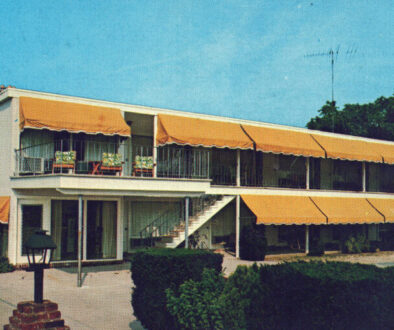1069 Michigan Avenue: The Saga Continues…

A lot has happened and unfortunately not happened since we wrote about the renovation of 1069 Michigan Avenue in the fall of 2022. I can’t believe I purchased this property more than five years ago and it still has issues. Last spring I talked about problems with drainage, the pool, the irrigation system, and sewage in the crawl space. Although some of those issues have been resolved, some haven’t, and new ones have appeared.
Drainage continues to be problematic. The system has been redone by a different contractor and is still not working properly. Heavy rain causes it to back up, and the gutters (which can’t handle all the water that comes off this enormous roof) spill over and create small rivers below along the edges of the garden beds. Those little streams continually wash mulch into the lawn. The new contractor disconnected one of the downspouts in preparation to reroute it, but he never returned to finish the job.
A second water meter for the irrigation system was postponed during the original construction due to budget constraints. We finally started the process in January of 2023, but it took until July to complete. What a disaster it turned out to be! The contractor couldn’t seem to acquire the new meter from the city—a fact he failed to communicate for a number of months. Tree roots (which should have been anticipated given the location of the meter) made digging extremely difficult. What should have taken a couple hours took two days. The plumber (not the landscaper) was sent to dig the hole. So, one plumber shoveled while two other plumbers watched. As you might expect, the final cost came in at more than double the estimate. To add insult to injury, the meter was installed too low in the ground making it impossible to plant grass around it. Apparently, it doesn’t work right either because the city returns each quarter to read it manually.
Those same tree roots resulted in blockage to the sewer line. (When we replaced that line last year, they didn’t go quite all the way to the street.) So far, we have had to dig up the front yard four times.
Our beautiful patio by the pool has issues, too. Apparently, the polysand didn’t harden correctly, resulting in weeds galore. There are more spinners stuck in the joints of those tiles than you can count! Since most of the sand is gone now, the tiles have shifted slightly, causing four of them to break during the winter due to the stress of the pool cover.
Speaking of the pool, two of the actuator valves are not working properly. Mysteriously, they are not Pentair valves, as they should be given the entire system is Pentair, so they are not under warranty. One LED light in the spa failed and had to be replaced. Fortunately, it was under warranty. What do you know? We finally caught a break!
The outdoor shower has a leak somewhere in the wall behind the stone veneer. It was discovered last fall when the back of a garage cabinet started to show signs of moisture and mold. Stay tuned—last year we decided to wait until spring to fix it. The stucco on the front of the house failed and has numerous cracks in it probably because it was too cold when it was installed. We cannot run the air conditioning on the sun porch due to condensation that has damaged the ceiling. The screens have also proven to be a problem because they allow too much wind (and rain) to come in.
One at a time we are addressing these seemingly endless issues. In the meantime, we are soothed by nature’s beauty in our gardens.
Garden Update


Let’s start with the successes. As you might expect, the hydrangeas of all varieties, shrub roses, ornamental grasses, and butterfly bushes are thriving, as are the evergreens (boxwoods, skip laurels, aucuba, and a dwarf Alberta spruce). Japanese hollies can be a little finicky. The two that flank the garage are okay, but I think they could benefit from some additional water given the amount of heat the driveway produces.
I am pleased to report that all the trees we planted are doing well. I am especially delighted that the Hornbeams are happy! I know they are supposed to be fast growers, but they have more than doubled in width in only three years. We will have our hedge on stilts before you know it!
Most of the shrubs, especially the deutzia, callicarpa, viburnums, clethra, and red twigged dogwood are doing exactly what we want them to do each year. The old-fashioned lilac was planted incorrectly (none of the burlap or strings were removed). So, it struggled to get going but is doing much better this year. The trellised euonymus is performing exactly like I had hoped although I didn’t consider how it would grow through the fence. I have to go onto my neighbor’s property to keep it tidy.



Perennials: The Visions astilbe and variegated liriope are happy as clams. All the hostas and the hakonechloa look great, too. It took a couple years, but the irises are breathtaking. These flowers are some of my favorites. They were given to me by my mother’s neighbor when I purchased my first home in 1987. The original six-inch pot has spawned hundreds if not thousands of offspring that now grace my friends’ gardens and a public park. They have even been sold at the Garden Club of Cape May’s semi-annual plant sale. If you would like some of your own, I’m sure they will be available at next year’s sale, too!
Some Disappointments
Lest you think that professionals, who supposedly know what they’re doing, don’t have problems to overcome in their gardens, let me assure you: we are challenged by many of the same issues that amateur gardeners face. In fact, sometimes I think we can be our own worst enemies, falling prey to wishful thinking and not paying enough attention to the plant tags—just like everyone else. However, some things are just mysterious. Take for example, my new rhododendrons that did not set buds this year. How disappointing! It could be too much shade, not enough fertilizer or maybe they just need another year to get established. We’ll just have to wait and see.
Mystery number two: the rainbow leucothoe aren’t doing much. They kind of just sit there. Since this is my first first-hand experience with them, I am not sure what the issue is. I think a little research is in order.
Too much sun is why the Nelly Moser Clematis peters out in mid-summer. Although gorgeous in the spring, it needs to have some shade come July. I think of clematis as being a sun lover but the tag (if I had paid attention) clearly said part shade! The Elijah blue fescue falls into the same scenario. They survive, but they are not as blue as they should be.

The number one challenge on this property is the soil. When I purchased 1069 Michigan Avenue, the soil was surprisingly good, not too sandy. However, the addition of new topsoil did not counteract the damage caused by the regrading of inferior fill and compaction. Few, if any amendments were added during planting—a huge oversight on my part.
Hailing from north Jersey, I am quite adept at dealing with hungry deer. But it seems I have a lot yet to learn about rapacious rabbits. They have decimated my precious heirloom fern, the crocuses, and the dianthus and most likely were a contributing factor to the demise of the tall garden phlox (although too much shade and not enough water when they were initially planted didn’t help either).
The crape myrtles have been plagued by aphids, and the hybrid tea roses were covered with black spots last year. Although no permanent damage was done, we will need to get a jump on those issues asap to prevent them from returning. I was also a little disappointed when the crape myrtles bloomed for the first time. This variety is categorized as dark purple, but they are really more of a deep magenta.
Too much water is the likely cause of the creeping phlox being smaller this year and blooming less. Until the drainage/gutter issue is resolved these poor little darlings are probably going to struggle. Of course, the amount of rainfall this spring didn’t help.
The PJM rhododendron in the front yard has been replaced twice. The first time it was insufficient water. But I should know better—it just isn’t the right spot for a rhodi no matter how much I want it to be. There is just too much wind, which is why the Autumn azaleas are struggling, too (two of them are doing fine, two croaked). The problem is I can’t seem to find an alternative that fits the bill.
Pleasant Surprises
Planted late last year after sitting in the garage for a month, the new peonies that were purchased to commemorate our first wedding anniversary either did nothing or died back after they were planted. I was disappointed, but hopeful. This spring, three of them are actually going to bloom and three more are doing fine and should bloom next year.
The three double rose of sharons are thriving. What tough beauties they are. One of them was moved three times during the construction and it didn’t seem to faze it a bit. The neon sedums are larger than life—literally. One of them is actually too happy and needs to be divided already!
The silver annuals (Angel Wings and Silver Bullet Dusty Miller) are performing like perennials for the third year in a row.
My favorite new plant is Tiny Tortuga Turtlehead (Chelone lyonii). Provided the landscaper doesn’t trample it in early spring, its snapdragon-like purple blossoms appear in late summer and last into the fall—a long time for a perennial. I love it so much I found a taller version that is now very happy in the backyard. The shorter variety would probably be better planted en masse.
Gardens are living things. They grow, they change, they give birth, and they die. They frustrate us and give us joy. They teach us patience. They are always works in progress. I can’t wait to get back to work in mine! I would like to leave you today with one last thought by Janet Kilburn Phillips who reminds us, “There are no gardening mistakes, only experiments.” Happy planting.



